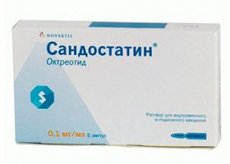Medical expert of the article
New publications
Preparations
Sandostatin
Last reviewed: 03.07.2025

All iLive content is medically reviewed or fact checked to ensure as much factual accuracy as possible.
We have strict sourcing guidelines and only link to reputable media sites, academic research institutions and, whenever possible, medically peer reviewed studies. Note that the numbers in parentheses ([1], [2], etc.) are clickable links to these studies.
If you feel that any of our content is inaccurate, out-of-date, or otherwise questionable, please select it and press Ctrl + Enter.

Indications Sandostatin
Among the indications:
- acromegaly (in situations where surgery, treatment with dopamine agonists, and radiation therapy have been ineffective or cannot be used);
- endocrine types of tumors in the gastroenteropancreatic structure (to eliminate the symptoms of carcinoid-type tumors with carcinoid manifestations, as well as tumors in which increased production of vasoactive intestinal polypeptide is observed);
- gastrinoma, Werner-Morrison syndrome, insuloma;
- glucagonoma;
- tumors in which increased production of somatoliberin is observed;
- refractory diarrhea in patients with AIDS;
- to prevent possible complications after laparotomy of the pancreas;
- bleeding (also to prevent relapse) due to varicose veins in the esophagus or stomach in patients suffering from liver cirrhosis (emergency therapy is carried out).
Pharmacodynamics
Pharmacokinetics
After the drug is injected under the skin, it is completely and very quickly absorbed. The peak plasma concentration is reached within half an hour.
It binds to plasma proteins by 65%, but the binding to blood cells is very weak. The distribution volume is 0.27 l/kg. The overall purification coefficient is 160 ml/min.
The half-life after subcutaneous injection is approximately 100 minutes. After intravenous administration, the drug is eliminated in two separate phases, with half-lives of 10 and 90 minutes, respectively.
Dosing and administration
For the treatment of acromegaly, as well as tumors in the gastroenteropancreatic structure, the drug should be administered subcutaneously at a dosage of 0.05-1 mg 1-2 times per day. If necessary, the dosage may be gradually increased to 0.1-0.2 mg three times per day.
For the treatment of refractory diarrhea that develops with AIDS, 0.1 mg of the drug is injected subcutaneously three times a day. The dose may be gradually increased to 0.25 mg three times a day.
As a preventive measure against complications after laparotomy on the pancreas – the 1st dose should be administered subcutaneously 1 hour before the operation (0.1 mg). After the procedure, the medicine should be administered subcutaneously in the amount of 0.1 mg three times a day for 1 week daily.
To stop bleeding in the stomach or esophagus caused by varicose veins in them, a dosage of 25 mcg/h is prescribed (continuous intravenous infusion is performed) for 5 days.
Use Sandostatin during pregnancy
There is no data on the use of Sandostatin in women during lactation and pregnancy, therefore the drug is only allowed to be prescribed to them for absolute indications.
Contraindications
Contraindications include individual intolerance to octreotide and other components of the drug.
 [ 18 ]
[ 18 ]
Side effects Sandostatin
The use of the drug may provoke the following side effects: vomiting with nausea, flatulence, diarrhea, loose stools, anorexia. In addition, abdominal colic, fatty feces, signs of acute intestinal obstruction (increasing flatulence, sharp pain in the epigastric region, tension and pain in the abdominal wall are felt upon palpation). Liver dysfunction may also develop, and as a result of prolonged use, gallstones may occur. In addition, hypo- or hyperglycemia, acute pancreatitis, alopecia and post-alimentary glucose tolerance disorder may develop. Itching, pain, burning may be felt at the injection site, the skin may swell and turn red.
Overdose
No life-threatening reactions have been observed following acute overdose. Normal overdose may result in the development of the following symptoms: slow heart rate, abdominal cramps, nausea, diarrhea, flushing of the face, and a feeling of emptiness in the stomach.
Therapy in this case involves symptomatic treatment.
Interactions with other drugs
Sandostatin reduces the absorption of cimetidine and cyclosporine. In patients with diabetes mellitus who receive insulin, the drug may reduce the need for the latter.
 [ 26 ]
[ 26 ]
Storage conditions
The medicine should be protected from sunlight and children. It should be kept in the refrigerator. Temperature conditions are 2-8°C.
 [ 27 ]
[ 27 ]
Attention!
To simplify the perception of information, this instruction for use of the drug "Sandostatin" translated and presented in a special form on the basis of the official instructions for medical use of the drug. Before use read the annotation that came directly to medicines.
Description provided for informational purposes and is not a guide to self-healing. The need for this drug, the purpose of the treatment regimen, methods and dose of the drug is determined solely by the attending physician. Self-medication is dangerous for your health.

